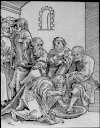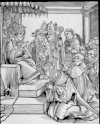 Because of the low literacy rates of Europe at the time, much of this
propaganda took form in images. One popular target for such images was
the pope, here portrayed by
Lucas Cranach
as the "Whore of Babylon."
Because of the low literacy rates of Europe at the time, much of this
propaganda took form in images. One popular target for such images was
the pope, here portrayed by
Lucas Cranach
as the "Whore of Babylon."
 Because of the low literacy rates of Europe at the time, much of this
propaganda took form in images. One popular target for such images was
the pope, here portrayed by
Lucas Cranach
as the "Whore of Babylon."
Because of the low literacy rates of Europe at the time, much of this
propaganda took form in images. One popular target for such images was
the pope, here portrayed by
Lucas Cranach
as the "Whore of Babylon."
The major producer of images in this time was Durer, whose "Vision of Seven Candlesticks" - (where Christ appears to John - Revelation 1:12 on) is shown here.
In another series of what might be termed "political cartoons" entitled the Passion of Christ and Anti-Christ Luther contrasts the life and actions of Christ with those of the Pope.
 |
Jesus washes the feet of his disciples. |
 |
The Pope makes others kiss his feet. |
|---|---|---|---|
 |
A crown of thorns is prepared for Christ. |
 |
The Pope wears three crowns of gold. |
This propaganda was effective in challenging the power of the Roman Catholic church, primarily because the Church itself had done such a wonderful job of educating the otherwise illiterate masses. While few book audiences of today would know the story of the Whore of Babylon, virtually all of Europe was familiar with the text and was capable of understanding the cartoon.
This page last updated on: Jan 30 1997